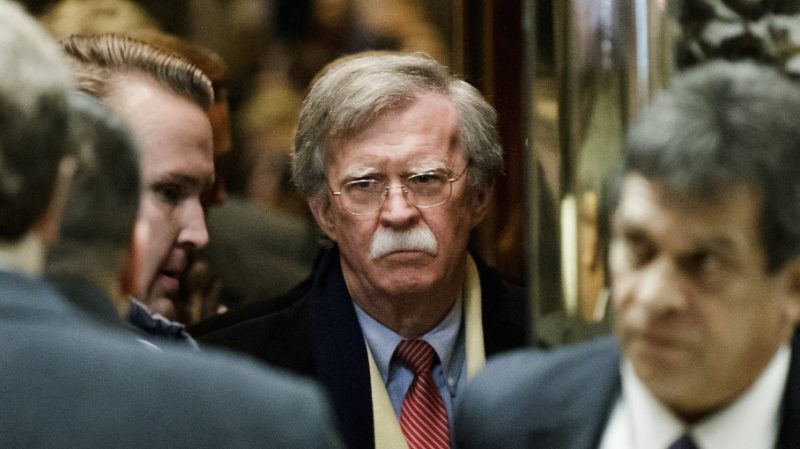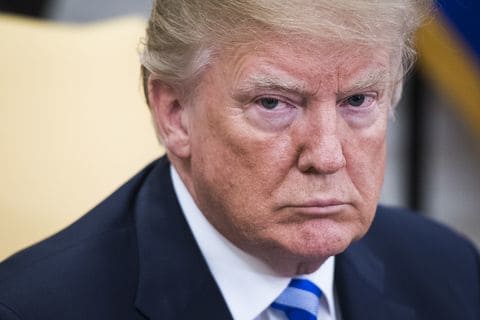The biggest obstacle Donald Trump is going to face in his upcoming negotiations with Kim Jong-un, is not Kim’s unwillingness to abandon his nuclear weapons program, but resistance from powerful elements in the foreign policy establishment who will do everything they can to scuttle the agreement.
We’ve already seen an example of this just this week when US nuclear bombers were included in the US-Korea joint military drills that are currently underway in the south.
The B-52′s were clearly added to the massive “Max Thunder” exercises to provoke the DPRK leadership, increase tensions, and convince Kim that it was pointless to trust Washington. The move was bitterly criticized in North Korea’s state media which summed up the situation like this:

“At a time when the DPRK-U.S. summit is approaching, the U.S. has launched the largest ever drill involving B-52 strategic nuclear bomber, F-22 Raptor stealth fighters and other nuclear strategic assets. This is an extremely provocative and ill-boding act going against the trend for peace and security on the Korean peninsula ….The extremely adventurous 2018 Max Thunder joint air combat exercises are aimed at precision strike on key strategic objects of the DPRK and the seizure of the air control together with the U.S….”
The North’s assessment is entirely correct. The drills are a simulation of a preemptive attack on North Korea that would annihilate the military, level Pyongyang and “decapitate” the leadership. They are a deliberate provocation designed to poison the atmosphere prior to the June 12 summit in Singapore.
They’re also a clear violation of the Panmunjom Declaration which affirms the mutual commitment of the North and South “to completely cease all hostile acts against each other in every domain, including land, air and sea, that are the source of military tension and conflict.” (Panmunjom Declaration)
What we’d like to know is whether Trump was consulted about the drills?
Did he give the go-ahead?
Was it his decision to tweak Kim’s nose after Kim had just made a number of conciliatory gestures including the total banning of nuclear weapons and ballistic missiles tests, the returning of three US prisoners to US custody, and meeting with leaders in the south in order to end hostilities and normalize relations?
Is Trump responsible for this diplomatic disaster?
Of course not.
Trump’s objectives are completely clear. He wants to win the Nobel Prize and he wants to be recognized as a foreign policy genius, both of which are within his grasp if he persuades Kim to ditch his nukes. Trump does not want to provoke Kim who, so far, has acted in good faith. He wants to cut a deal with him.
The exercises represent the interests of some other constituency, some deeper faction within the national security state who have a stake in the outcome of future negotiations. They want the talks to fail so they can preserve the status quo. They want a divided Korea that “languishes in a permanent state of colonial dependency”.
That works just fine for them, which is why the military drills were not postponed or cancelled. It’s also why John Bolton has been making incendiary comments about the “Libya model”, and why the media has been fueling public pessimism while misrepresenting US position.
According to many media reports, the North will be expected to ‘totally decommission its nuclear weapons, missiles and biochemical weapons’ without any immediate compensation.
That’s not the deal. That’s never been the deal. No one on the North Korean side ever said that Washington was going to get something for nothing. And it’s not going to happen either. Kim is looking for a tradeoff, a decommissioning of his nuclear weapons in exchange for basic security guarantees.
That’s the deal.
So who’s spreading all these false rumors and what is their objective? Here’s more from North Korea’s state media:
“The U.S. is miscalculating the magnanimity of the DPRK as signs of weakness and trying to embellish and advertise as if these are the product of its sanctions and pressure.
The U.S. is trumpeting as if it would offer economic compensation and benefit in case we abandon nukes. But we have never had any expectation of U.S. support in carrying out our economic construction and will not make such a deal in future….
If the Trump administration takes an approach to the DPRK-U.S. summit with sincerity for improved DPRK-U.S. relations, it will receive a deserved response from us.
However, if the U.S. is trying to drive us into a corner to force our unilateral nuclear abandonment, we will no longer be interested in such dialogue and cannot but reconsider our proceeding to the DPRK-U.S. summit.” (End of statement)
The North doesn’t want Washington’s money or its economic inducements. The North wants assurances that the US will not attack it in the future.
That’s it.
That’s what Kim wants. He wants an end to the hostilities so he can move ahead with a regional economic-integration plan that will draw the two Koreas closer together, end the North’s isolation, strengthen the North’s economy, and pave the way for prosperity.
In other words, Kim is offering to give up his nuclear weapons to (essentially) get Washington off its back and out of its hair.
None of this has anything to do with Trump’s absurd “maximum pressure” campaign, which had no impact on Kim’s decision at all.
The North is not motivated by Trump’s hysterical threats of “total destruction”, but by a once-in-a-lifetime opportunity to emerge from its long-term seclusion and become an active participant in an ambitious economic integration plan that will link North and South Korea to the rest of Asia via massive infrastructure and energy projects.
The only catch to this proposal, is that the DPRK must abandon its nuclear weapons program and agree to resolve its issues with Seoul. In other words, Kim’s eagerness to denuclearize is not an attempt to placate Washington, but an effort to meet the minimal requirements of his economic partners in Beijing, Moscow and Seoul.
The United States is not central to the critical economic-political developments on the peninsula, in fact, the region is making a concerted effort to sever its ties with Washington by creating a giant free trade zone that will connect the region through ” large trilateral infrastructural and energy projects,” to Japan, Southeast Asia, Central Asia and Europe.
Check this out from the Kremlin website:
“The Korean Government has recently created the Northern Economic Cooperation Committee… This has completed the creation of a management system that will make Korea the leader in the development of the Far East. The Committee is tasked with strengthening economic cooperation with Northeast Asian and Eurasian countries.
In the future, cooperation between the Committee and Russia’s Far Eastern Federal District and the Ministry for the Development of the Russian Far East will play a key role in the development of the Far East.
Next year, we will create a Korean-Russian Regional Cooperation Forum. It should bolster contacts between regional governments in Korea and the Russian Far East. Cooperation channels between regional economic communities and small and medium-sized businesses will greatly expand contacts between people and promote practical cooperation…..
The North Korean nuclear and missile ambitions are the biggest threat to the development of the huge potential of the Korean Peninsula and the Russian Far East. This is why we have come to the conclusion that this problem must be settled as soon as possible.” (Kremlin website)
See what’s going on? Kim has been asked to choose between prosperity or nukes, and he has wisely chosen prosperity. He has decided to participate in a common economic space that allows commerce to flourish without the bulk of the profits to be siphoned off by the voracious western corporations.
Is it any wonder why powerful members of the foreign policy establishment want to torpedo the plan?
The integration plan is not some pie-in-the-sky apparition, but a broad and detailed economic blueprint for regional development; power plants, highways, high-speed rail, and pipeline corridors. It’s the whole nine yards.
Here’s more from The South China Morning Post:
“President Moon Jae-in gave the North’s leader Kim Jong-un a USB drive containing a “New Economic Map of the Korean Peninsula” at the fortified border village of Panmunjom on April 27.
The initiative included three economic belts – one connecting the west coast of the peninsula to China, making the region a centre of logistics; one connecting the east coast to Russia for energy cooperation and one on the current border to promote tourism. “The new economic map includes railway links between the two Koreas and China’s northeast stretching all the way to Europe….”
…
“The plan would have a huge impact on China’s northeastern region as it would transform the region as a centre of logistics in East Asia, which could function as a driving force for the rapid economic growth of the region….A railway connection would bring a myriad of investments from overseas and would help the economy take off.”
Yet observers added that the initiatives were dependent on Kim accepting Seoul’s definition of denuclearisation – namely the complete, verifiable and irreversible dismantling of the North’s nuclear programme.” (The South China Morning Post)

Kim must denuclearize in order to take advantage of this unprecedented opportunity, which is why he is eager to make hefty concessions to Trump while getting very little in return. Think about it: Trump gets the nukes and the Nobel Prize while Kim gets a lousy piece of paper with Washington’s guarantees for security.
That’s a great deal for Trump but not a very good deal for Kim.
Even so, Kim is prepared to cooperate in order to meet his obligations and move forward with an economic plan that will strengthen his economy and improve the lives of his people. He’s making the right choice.
Some of Trump’s deep state opponents probably think that they can derail Kim’s plans by sabotaging the June 12th Summit. But that’s not entirely true.
Kim does not need to reach an agreement with Trump, he merely has to convince his main trading partner, Beijing, that he’s made a sincere effort that was rejected by an unreasonable and tyrannical Washington.
If Kim proves that he’s willing to go the extra mile for peace– by offering to decommission his nuclear arsenal– then Beijing is going to reward his behavior by easing the sanctions and restoring the DPRK’s economic lifeline. Bottom line: Kim is going to win one way or another.
In my opinion, the cat-n-mouse game Kim is playing with Trump is a bit of a ruse because, in truth, Kim is going to have to give up his nukes whether he makes a deal with Trump or not.
As we said earlier, Moscow, Beijing and Seoul have all made denuclearization a basic requirement for participation in their economic integration plan, so it’s a done deal. Kim is going to have to abandon his nuclear weapons.
The fact is, Russia and China don’t want the smaller, surrounding nations to have nukes any more than the US wants Mexico, Canada or Cuba to have them. It dramatically impacts regional security.
Finally, it wouldn’t surprise me if Washington’s deep state power brokers are more concerned about the proposed regional free trade zone, then they are about the North’s nuclear weapons.
In order for the US to be a major player in the most populous and prosperous region in the world, it must implement its “pivot to Asia” strategy that controls China’s explosive growth and prevents the emergence of an economic or military rival.
The so called “Putin Plan” for vast economic integration is a direct threat to Washington’s dream of maintaining its dominant position in the global economy. If successfully implemented, the Putin Plan will greatly accelerate the pace of imperial decline.
So far, I don’t see any indication that Washington knows how to deal with this threat.
*
By Mike Whitney, The Unz Review
The 21st Century
The Need for a New U.S. Foreign Policy Toward North Korea
